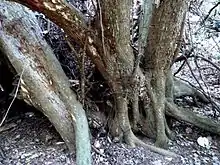Chaetachme
Chaetachme is a monotypic genus of flowering plants native to eastern and western Africa, including Madagascar,[2] containing the single species Chaetachme aristata. Its English common name is thorny elm,[3] and it is known as muyuyu in Kikuyu.[4] Traditionally placed in the Elm family, it is more recently placed in the family Cannabaceae, thought to be possibly closely related to Celtis.
| Chaetachme | |
|---|---|
 | |
 | |
| Scientific classification | |
| Kingdom: | Plantae |
| Clade: | Tracheophytes |
| Clade: | Angiosperms |
| Clade: | Eudicots |
| Clade: | Rosids |
| Order: | Rosales |
| Family: | Cannabaceae |
| Genus: | Chaetachme Planch. |
| Species: | C. aristata |
| Binomial name | |
| Chaetachme aristata | |
| Synonyms[1] | |
| |
Chaetachme aristata is a shrub or small tree growing up to 10 meters tall. It has drooping, angular branches covered with spines up to 3.5 centimeters in length. The lance-shaped leaves are up to 11 centimeters long by 5 centimeters wide, pointed at the tip and smooth or serrated on the edges. The shrub is dioecious and sexually dimorphic, with male and female flower types borne on separate individuals,[2][5] although it may also be monoecious.[6]
This shrub is host to the mirid bug Volumnus chaetacme.[7]
The spiny branches of the shrub are used as fences in African villages.[4][8]
References
- "Chaetachme aristata Planch". The Plant List (2013). Version 1.1. Retrieved 5 March 2014.
- "JSTOR Global Plants: Search Results". plants.jstor.org. Retrieved 2017-08-01.
- Trees & Shrubs of East Africa. Archived 2018-04-08 at the Wayback Machine Safari Patrol
- "Glossary". www.fao.org. Retrieved 2017-08-01.
- Arusha Region. Archived 2011-08-13 at the Wayback Machine The management and ecology of Tanzanian forests
- Yang, Mei-Qing; Van Velzen, Robin; Bakker, Freek T.; Sattarian, Ali; Li, De-Zhu; Yi, Ting-Shuang (2013). "Molecular phylogenetics and character evolution of Cannabaceae". Taxon. 62 (3): 473–485. doi:10.12705/623.9.
- Linnavuori, R. (1996). Taxonomic studies of the Miridae (Heteroptera) of Africa and the Middle East. Acta Universitatis Carolinae Biologica 40 321-50.
- Bussmann, R. W., et al. (2006). Plant use of the Maasai of Sekenani Valley, Maasai Mara, Kenya. J Ethnobiol Ethnomed 2 22.